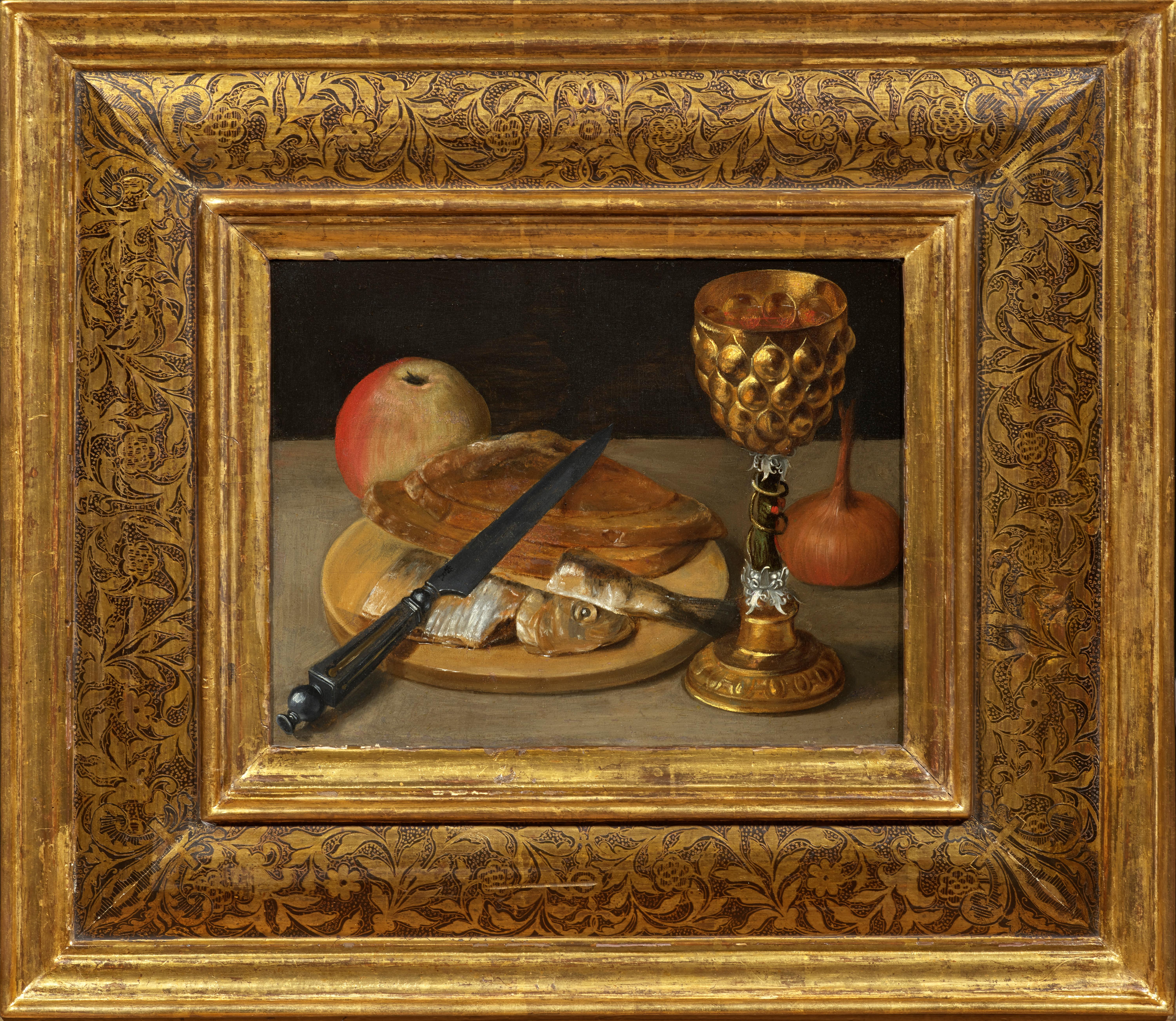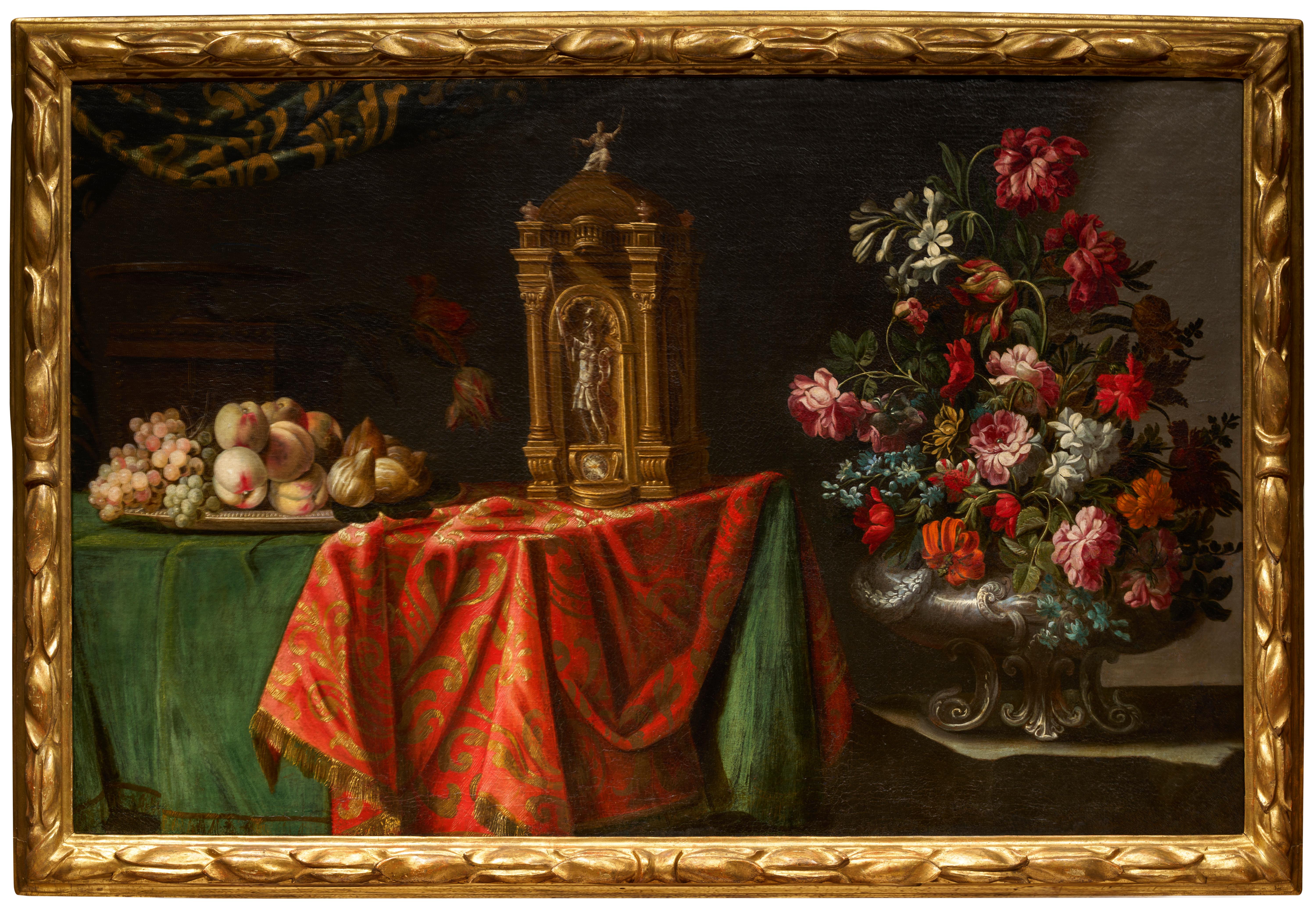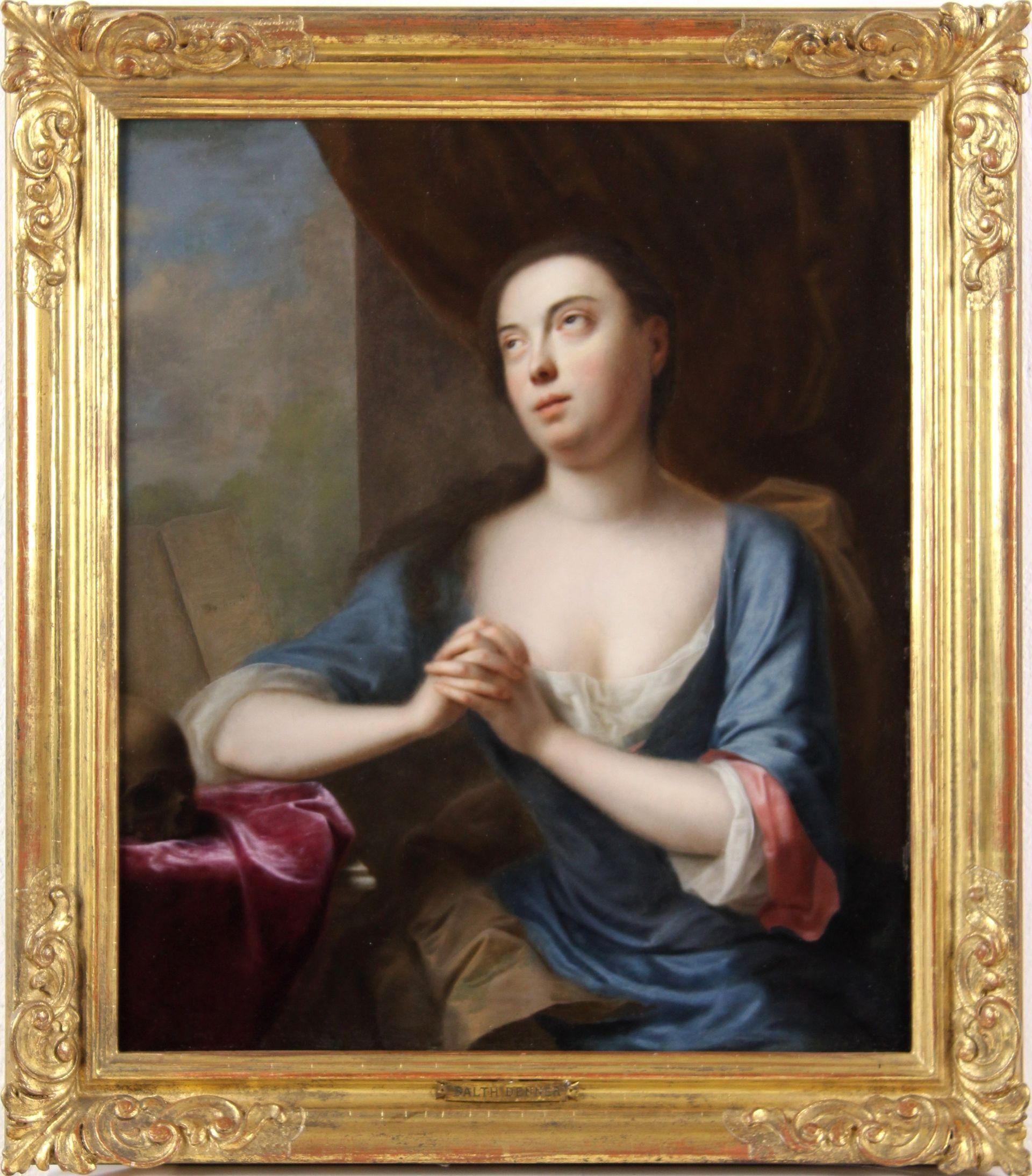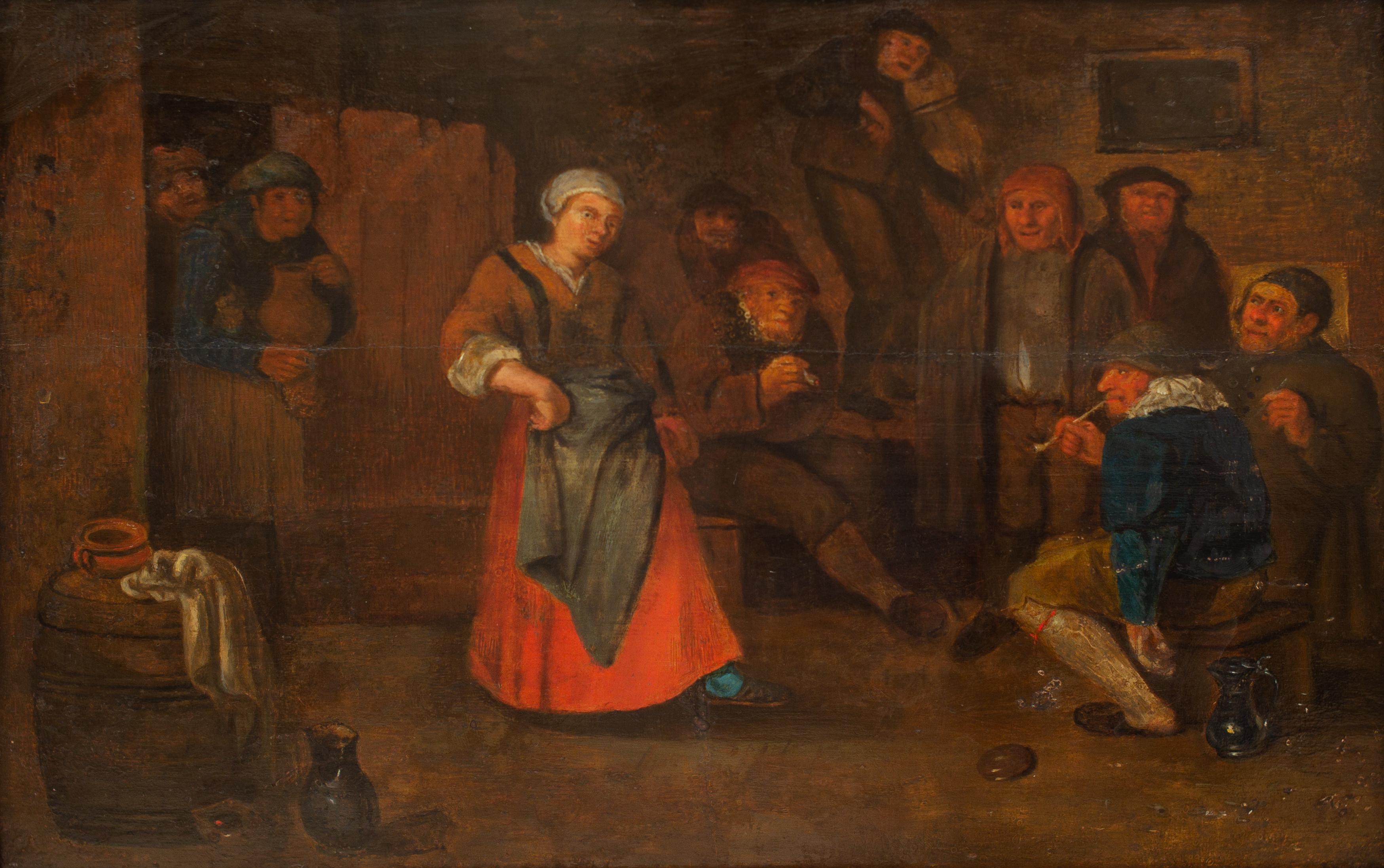Items Similar to Attributed à H. Francken II, 17th c. Anwerp - The prodigal son among courtesans
Want more images or videos?
Request additional images or videos from the seller
1 of 16
Attributed à H. Francken II, 17th c. Anwerp - The prodigal son among courtesans
About the Item
The Prodigal Son Among Courtesans
Attributed to Hieronymus Francken II (Antwerp 1578-1623)
Early 17th century Antwerp school
Oil on oak panel,
Dimensions: H. 52.5 cm (20.67 in), W. 74 cm (29.14 in)
Flemish-style moulded wood frame
Frame: h. 78 cm (h. 30.70 in.), w. 100 cm (39.37 in.)
At first glance, this festive and joyful painting depicts a group of elegantly dressed people dancing to the sound of an orchestra in a richly decorated interior with a wide opening onto a rural exterior. However, the real theme is cleverly concealed by the painter and is only discernible through the artifice of a small scene in the background where we see a half-naked man, in the company of the pigs next to a makeshift shelter.
In fact, beyond the pleasant and apparently superficial character of the painting, it is a subject taken from the parable of the prodigal son in the Gospel. The illustrated episode is the prodigal son among courtesans.
Even if the viewer's attention is drawn to the central couple (prodigal son embracing a pretty courtesan) doing the dance steps, the artist takes care in a narrative approach of all the groups and ancillary scenes in order to create a rich and varied composition. Thus the musicians seated on a raised platform are depicted with great skill, their faces animated, their clothes abundantly varied.
The theme of music, which has always been associated with that of sensuality and physical love, helps to exacerbate licentious pleasures.
The merry company dances "Spanish pavane", a slow court dance from the sixteenth century, danced close to the ground by couples arranged in a procession, which was probably introduced to the south of the Netherlands around 1600 during the governance of Albrecht VII and the daughter of the King of Spain Isabella Clara Eugenia in Brussels.
The interior of the house is also carefully elaborated, the embossed leather dyes on the walls, the middle sideboard (typical in Francken interiors), where the rich gold and silver crockery is placed in front of the painting "Andromeda chained to the rock and Perseus arriving to rescue her". The inclusion of a contemporary and probably extant pictorial work is also one of the characteristics of the Francken family, among them Frans Francken the Younger is particularly known for his numerous interiors of amateur cabinets.
In the foreground, on the left, a table laden with fine food and precious crockery indicates the banquet that took place before the dance. The painter places several objects whose symbolism serves to reinforce decay and abuse: glasses filled with wine (drunkenness), a knife whose handle leans unbalanced at the edge of the table (instability), open oysters (the image of carnal pleasure), a broken lemon (a life started: symbol of the bitterness of the passing of time).
Finally, in the third left ground, two men standing, wrapped in cloaks, look at the whole scene, one can easily imagine two bandits who have arrived to steal the prodigal son's money, their weapons hidden under their coats. No matter how it happens again, the prodigal son will end up ruined, even leaving his shirt there, and this is how the painter depicts him in the background: kneeling among the pigs, he seems to reflect on his downfall and decides to return to his father. In reality, the Gospels remain very discreet about the details of the debauchery life of the young man who went to squander his inheritance, yet there is a whole tradition in Antwerp painting from the sixteenth century onwards to complacently depict the debauchery of the prodigal son: meal, drink, gambling, courtesans. This technique makes it possible to divert a religious subject into a secular one.
The story of the Prodigal Son, which is constantly in the moralizing spirit, also serves as a pretext to point out licentious and amoral behavior. The decay embodied by the eviction from the brothel and life among the pigs are always relegated to the background. The proscenium, on the other hand, emphasizes the pleasures of music, dance and the flesh. Sin is absolute! This way of representing ball scenes in an interior at the Francken house would come from Hieronymus I Francken (around 1540-1610), who worked at the court of France at the end of the sixteenth century and was inspired by the many balls that took place there. His nephews, Frans Francken II and Hieronymus Francken II, were inspired by their uncle's compositions while adapting the ballroom scenes to their Flemish clientele, incorporating biblical morality against excesses into their works.
Related works:
Some works are very close to our painting with some minute variations in the setting or the characters' clothes.
• Koller auction, Zurich, 22/03/2013, oil on copper, by Hieronymus Francken II, signed DEN ION franck f (h. 44,5 cm, w. 65,5 cm)
• Christie’s New York 31/01/2013, oil on panel, h. 61 cm, w. 85 cm, by Hieronymus Francken II
• Musée de Tessé, Le Mans, After Hieronymus I Francken (Herenthals c. 1540 - Paris 1610) Ball during the reign of Henri III, oil on panel
• Private collection, illustrated in Ursula Harting, dated 1607, by Hieronymus Francken II, p.178 n. 150 (Frans Francken Der Jüngere (1581-1642). Die Gemalde mit kritischem oeuvrekatalog, 01/01/1989 Edition : Luca Verlag, monography on Frans Francken the Younger as well as his family)
Other compositions differ from ours, but have many similarities:
• The Prodigal Son Among Courtesans, Musée des Beaux Arts de Nimes, by Hieronymus I Francken, oil on panel
• Dance lesson, Musée des Beaux-Arts de Cambrai, by Hieronymus Francken II, oil on panel, h. 54 cm, w. 80 cm,
• The Prodigal Son Among Courtesans, Musée de Brou, Bourg-en-Bresse, by Frans Francken II, oil on copper, h. 40 cm, w. 52 cm, , signed Do. Franck
• Dancing company, Lempertz Auction, Köln, 14 May 2011, by Hieronymus Francken II, oil on panel, h. 49,5 cm, w. 71 cm
Hieronymus Francken II (Antwerp 1578-1623)
Hieronymus Francken II was the son of Frans Francken the Elder. His father was a painter born in Herentals who had moved with his painter father to Antwerp. There he had become one of the leading painters of the Counter-Reformation. Hieronymus had three painter brothers: Thomas, Frans II, and Ambrosius II. Hieronymus received his first training from his father. He was entered in the books of the Antwerp Guild of St. Luke in 1605 as a pupil of his uncle Ambrosius. In 1607, Hieronymus Francken II was officially admitted as Master of the Antwerp Guild. In 1609 he probably spent time in Paris, where, like his brother Frans II, he is said to have studied under his uncle Hieronymus Francken I. Hieronymus Francken I worked most of his life in Paris and Fontainebleau and was court painter to France from 1594. Hieronymus Francken II returned to Antwerp where he spent the rest of his life.
Hieronymus Francken the Younger was a versatile artist who practiced many genres. Hieronymus painted art galleries and cabinets of curiosities, genre scenes of balls and gallant dances, history paintings, antics, allegorical paintings, and still lifes. He also copied some witchcraft scenes, invented by his brother Frans II.
- Attributed to:HIERONYMUS FRANCKEN II (1578 - 1623, Flemish)
- Dimensions:Height: 30.7 in (77.98 cm)Width: 39.37 in (100 cm)
- Medium:
- Movement & Style:
- Period:Early 17th Century
- Condition:Professionnally restored, ready to be hanged and enjoyed.
- Gallery Location:PARIS, FR
- Reference Number:1stDibs: LU2433213372612
About the Seller
No Reviews Yet
Vetted Seller
These experienced sellers undergo a comprehensive evaluation by our team of in-house experts.
1stDibs seller since 2023
- ShippingRetrieving quote...Ships From: PARIS, France
- Return PolicyA return for this item may be initiated within 3 days of delivery.
More From This SellerView All
- 17th c. Flemish school - Allegory of the five senses - attributed to P. LisaertBy Pieter Lisaert IVLocated in PARIS, FR17th c. Flemish school - Allegory of the five senses - attributed to Pieter Lisaert (Antwerp, 1595-1629) Our attractive painting on wood immediately catches the eye with its bright a...Category
Early 17th Century Old Masters Interior Paintings
MaterialsOil, Wood Panel
- 16th c. Flemish school - Holy family - workshop Pieter Coecke Van AelstLocated in PARIS, FRHoly family with an angel, workshop Pieter Coecke Van Aelst (Alost, 1502 - Bruxelles, 1550) Faithful to the traditions of the late Gothic and early Renaissance, our painting depicts ...Category
16th Century Old Masters Interior Paintings
MaterialsOil, Wood Panel
- Virgin with child, workshop of Pieter Coecke Van Aelst, 16th c. Flemish schoolLocated in PARIS, FRVirgin and Child Workshop of Pieter Coecke Van Aelst (Aelst, 1502- Brussels, 1550) 16th century Oil on oak panel Dimensions: panel: h. 71.5cm, W. 48.5 cm (28.15 in x 19.09 in) Later ...Category
16th Century Old Masters Figurative Paintings
MaterialsOak, Oil
- Ascension day in Venice by Louis de Caullery (1582-1621) 17th c. Flemish schoolLocated in PARIS, FRAscension Day in Venice 17th century Antwerp School Louis de Caullery (1582-1621) Oil on oak panel Dimensions: h. 12.8 in, w. 23.03 in (h. 32,5 cm, w. 58,5 c...Category
Early 17th Century Old Masters Landscape Paintings
MaterialsOil, Oak
- Rest on the Flight into Egypt - Attributed to Pieter Van Avont - 17th c. FlemishBy Pieter van AvontLocated in PARIS, FRRest during the Flight into Egypt - The Virgin and Child with St. John the Baptist and the angels in a Landscape. Attributed to Pieter Van Avont (1600-1652) 17th century Antwerp School, circa 1630 Oil on oak panel, Dimensions: h. 38 cm, w. 50 cm (14.96 in x 19.68 in) Flemish style frame in ebonized and moulded wood Framed: h. 56 cm, w. 68.5 cm (22.04 in. x 26.97 in.) In the heart of a lush wooded landscape, the Virgin with Jesus rests in a green clearing accompanied by Saint John the Baptist and the cherubs. Seated to the left of the composition, the Virgin Mary holds the Child on her lap; the little Saint John the Baptist wearing the camel-skin tunic (his attribute) stands before Jesus to exchange a few caresses. On the right, the couple of cherubs are playing with the lamb of Saint John the Baptist, bringing a jovial character to the scene. A pair of gardening putti on the left pick flowers to bring bouquets to the Virgin and Jesus. Spring flowers such as tulips, daffodils and anemones that grow abundantly around them and enrich the composition with their shimmering colors. A lush rose bush blooms to the left of the figures offering delicate roses. (The rose is the flower associated with the Virgin Mary, who is the "mystical rose," the one that does not bear the "thorn of sin") At the feet of the Virgin are bunches of grapes (symbol of the future passion of Christ) as well as apples (symbol of the original fall of Man but also of the Redemption in Christ) In the foreground we find a wicker basket filled in profusion with beautiful flowers and guinea pigs nibbling on the blades of grass. In a cleverly arranged disorder, these elements of the still life with their strong symbolic power accentuate the religious theme, but are also an opportunity for the artist to demonstrate his know-how in the still life genre that is gaining momentum in Antwerp. The landscape behind the figures consists of a large tree with a twisted trunk and a luminous opening to the horizon placed on the right. We see Saint Joseph arriving with a donkey, a small reminder from the artist that the composition is associated with the episode of Rest during the flight into Egypt. The calm expanse of this bucolic forest opening onto the luminous distance, with its profusion of symbolic flowers and fruits, is particularly suited to this sacred scene. The theme of Jesus' sacrifice and his tragic fate is mitigated by cherubs who play with innocence and carelessness in the face of the fragility of life symbolized by cut flowers. The great mastery of the painter is manifested by the finesse of the drawing enhanced by the delicacy in the application of the brushstrokes bringing a multitude of details. The richness of the whole is exacerbated thanks to the choice of colours, this varied palette is an undeniable asset of our work. The virtuosity of our artist lies in his versatility, as much concerned with the success of the landscape and flowers as with the modelling of his figures. The cherubs with their naked bodies are gracefully illuminated by warm colours with subtle shadows, while the still life is rendered with astonishing realism, both in the precision of the drawing and in the countless shades of the flowers. There are several compositions similar to ours, of which below are the closest versions: • Sale, Jean-Claude Anaf et Associés, Lyon, 08/02/1998, attributed to Pieter Van Avont, oil on panel, h. 48 cm, l. 71 cm (recorded on RKD n° 31451). Comment: identical composition, only St Joseph with the donkey is different) • Christie's New York sale, 29/01/1998, Pieter Van Avont, oil on copper, h. 23.8 cm, w. 24.8 cm • Dorotheum sale, Vienna, 25/04/2017, Pieter Van Avont and Jan Breughel II, oil on copper, h .26 cm, w. 39 cm • Hermitage Museum, Saint Petersburg, Russia, Pieter Van Avont, oil on panel, h. 50.5 cm, w. 71.7 cm Peter van Avont, Flemish painter (Mechelen, 1600 - Antwerp. 1652) Born in Mechelen, he is mentioned in 1620 as a member of the painters' guild of his hometown. He left in 1 622 for Antwerp, where he was also a member of the guild. He collaborated with many painters, including Jan Brueguel the Younger, David Vinckboons, Lucas van Uden...Category
17th Century Old Masters Landscape Paintings
MaterialsOak, Oil
- Madonna and child with angels, circle of Joos Van Cleve, 16th c. Antwerp schoolBy Joos van CleveLocated in PARIS, FRMadonna and Child with Saint John the Baptist and angels Circle of Joos Van Cleve (1485 – 1541) 16th century Antwerp school Oil on oak panel Dimensions: h. 32 cm (13 in.), w. 28.5 cm...Category
16th Century Old Masters Figurative Paintings
MaterialsOil, Oak
You May Also Like
- Scholar Sharpening His Quill Penn Attributed to Justus Juncker, Oil on PanelLocated in Stockholm, SEJustus Juncker (1703-1763, Germany) Attributed to Scholar Sharpening His Quill Penn Expertise: We would like to thank Dr. Fred G Meijer for his valuab...Category
Early 18th Century Old Masters Figurative Paintings
MaterialsOak, Oil, Panel
- Still Life with Herring, a panel by the workshop of Georg Flegel (1566 - 1638)Located in PARIS, FRFred G. Meier, art historian, confirmed with the following comment, after a photographic examination of the work, that it belongs to the studio of Georg Flegel...Category
1630s Old Masters Still-life Paintings
MaterialsOak, Oil
- Scholar Sharpening His Quill Penn Attributed to Justus Juncker, Oil on PanelLocated in Stockholm, SEJustus Juncker (1703-1763, Germany) Attributed to Scholar Sharpening His Quill Penn Expertise: We would like to thank Dr. Fred G Meijer for his valuab...Category
Early 18th Century Old Masters Figurative Paintings
MaterialsOak, Oil, Panel
- Baroque silver Vase with Flowers with a Fruit Tray and a Clock by A. ZuccatiLocated in PARIS, FRThis unpublished composition is a recent addition to Adeodato Zuccati’s catalog. The study of this painting by Gianluca Bocchi, an Italian art historian specializing in Italian still lives, is available upon request. This composition is typical of the productions of Adeodato Zuccati, an Emilian painter...Category
Late 17th Century Old Masters Still-life Paintings
MaterialsCanvas, Oil
- Mary Magdalene - Faith transforms inner into outer beauty and conquers death -By Balthasar DennerLocated in Berlin, DEBalthasar Denner (1685 Hamburg - 1749 Rostock). Mary Magdalene. Oil on copper, 37 × 32 cm (visible size), 45 x 40 cm (frame), signed and indistinctly dated "Denner 17(...)" at centre...Category
1720s Old Masters Figurative Paintings
MaterialsCopper
- Adriaen van Ostade (follower of) - A Woman Dancing to the Music from a ViolinBy Adriaen van OstadeLocated in Stockholm, SEAdriaen van Ostade (follower of) A Women Dancing to the Music from a Violin oil on oak panel panel size 10.23 x 15.35 inches (26 x 39 cm) frame 15.74 x 21.25 inches (40 x 54 cm) f...Category
18th Century Old Masters Figurative Paintings
MaterialsOil, Panel





